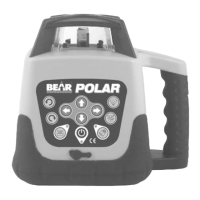— 20 —
Annex A:
Setting up for a manual grading application:
Notes:
• Forthefollowingprocedureitisrecommendedthattheremotecontrolisusedtoadjustthegrade
of the laser. This will ensure adjustments can be performed quickly and accurately.
• Ensurethestaffisheldverticalduringallreadings.Ifyourstaffdoesnothaveabubblethenmove
the staff backward and forward toward the beam and use the smallest reading for your
observations.
• ForbestaccuracyusetheGENNO-ROD(seepage:27)
• Warning!Donotdisturbthesetupofthelaserwhiletakingelevationreadings.Thelaseris
completely manual in this mode and any shifts will result in movement of the laser plane. This
methodofcreatingaslope/gradeisnotrecommendedforprecisionapplications.BearScientic
are not responsible for any mishaps that may result by following the process described below.
1. Setup the Bear Polar in horizontal mode and rotate the unit in such a way to align the X an
d Y axes with
the direction of the desired slopes.
2. Turn the laser on and allow it to self-level.
3. Establish a point (Point A) at a known horizontal distance along the desired run of the axis in
which you wish to set-up a grade.
(Note: The point should be set at an easily calculable distance to make measurements and
calculations easier. Example: 10 or 20 metres)
4. Calculate the Height Differential for your desired slope/grade as per the following formula:
Height Differential = (slope %) x (distance)
(See examples 1 & 2 below)
5. Take a “level” reading at Point A.
6. Add the “level” reading to the Height Differential to determine the “slope” reading you are
trying to establish at Point A

